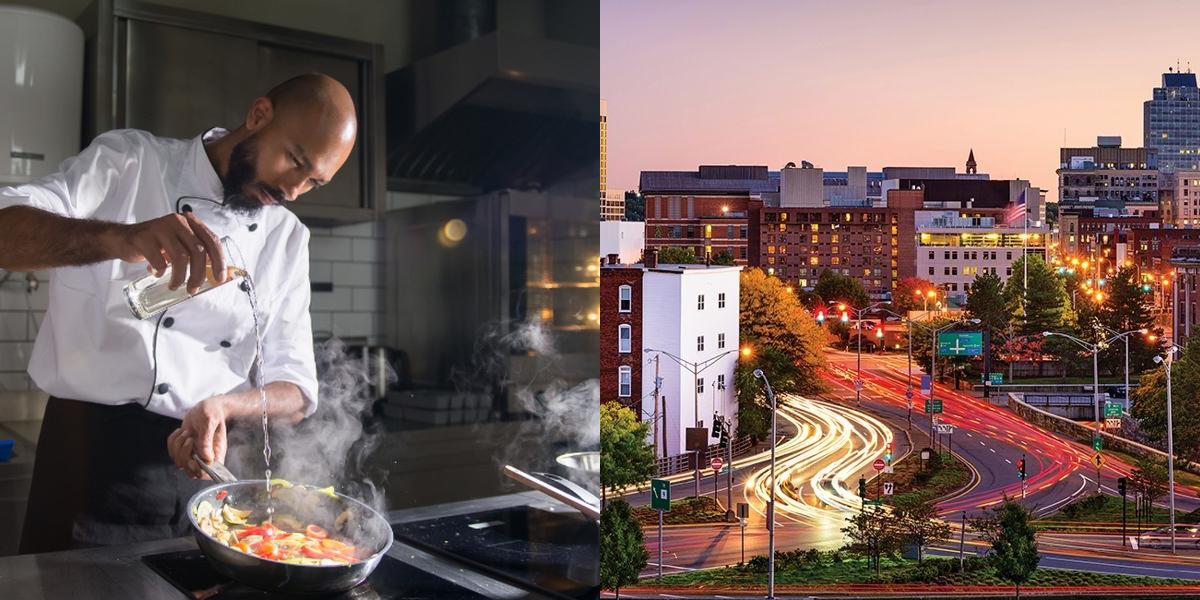How to Become a Chef in Massachusetts

Are you passionate about cooking and dreaming of becoming a chef in Massachusetts? If so, you're in the right place! In this blog post, we'll explore what culinary arts is, the responsibilities of a culinary artist, where they work, the requirements to become one in Massachusetts, and where you can find culinary arts classes in the state.
How do I get a job as a Culinary Arts?
Getting a job in the culinary arts industry requires a combination of culinary skills, experience, and networking. Here are some steps you can follow to increase your chances of landing a job as a culinary arts professional:
-
Gain culinary education and certification: Start by pursuing a culinary arts education and obtaining a culinary arts certification. As mentioned earlier, enrolling in a culinary arts program and completing the necessary coursework will equip you with the skills and knowledge required for a culinary career. Additionally, obtaining certification from reputable culinary education bodies such as the American Culinary Federation (ACF) adds credibility to your resume and demonstrates your commitment to the profession.
-
Build a strong foundation of culinary skills: Develop a strong foundation of culinary skills by mastering essential cooking techniques, food handling and safety protocols, and menu planning. Practice your skills regularly and experiment with different ingredients and cuisines to expand your culinary repertoire. The more skilled you are as a cook, the more attractive you will be to potential employers.
-
Gain practical experience: Practical experience is crucial in the culinary arts industry. Look for opportunities to gain hands-on experience in professional kitchens, restaurants, or catering establishments. Consider doing internships, externships, or apprenticeships to get real-world exposure to the culinary industry. Practical experience not only enhances your culinary skills but also helps you build connections and references that can vouch for your abilities.
-
Create a professional resume and portfolio: Craft a professional resume that highlights your culinary education, certifications, practical experience, and any relevant achievements or awards. Include a section on your culinary skills, such as knife skills, cooking techniques, and food presentation. Additionally, create a portfolio of your culinary creations, including photographs or descriptions of dishes you have prepared. A visually appealing and well-organized portfolio can impress potential employers and showcase your culinary talent.
-
Network within the culinary industry: Networking is essential in the culinary arts industry. Attend culinary events, trade shows, and industry conferences to meet professionals from the culinary industry. Join culinary associations and organizations, such as the American Culinary Federation (ACF), and participate in their events and activities. Networking can lead to job opportunities, mentorship, and valuable connections in the culinary industry.
-
Apply for culinary jobs: Once you have gained the necessary culinary skills, education, and experience, start applying for culinary jobs. Look for job openings in restaurants, hotels, resorts, catering companies, and other culinary establishments. Use online job portals, professional networking websites, and culinary job boards to search for job opportunities. Tailor your resume and cover letter to each job application, emphasizing your relevant skills and experience.
-
Prepare for job interviews: Before attending job interviews, research the culinary establishment you are applying to. Familiarize yourself with their menu, cuisine, and culinary style. Practice common interview questions and prepare examples of your culinary achievements or challenges you have overcome in the kitchen. Dress professionally and bring any necessary documents, such as your culinary certifications or portfolio, to the interview.
-
Show enthusiasm and a willingness to learn: During job interviews, demonstrate your passion for culinary arts and your eagerness to learn and grow in the industry. Highlight your ability to work well in a team, follow instructions, and adapt to fast-paced kitchen environments. Employers value candidates who are enthusiastic, reliable, and willing to go the extra mile to ensure customer satisfaction.
By following these steps and staying persistent, you can increase your chances of landing a job as a culinary arts professional.
Career Paths and Opportunities after Becoming a Culinary Arts
After becoming a culinary arts professional, there are various career paths and opportunities you can explore within the culinary industry. Here are some common career paths you can consider:
-
Chef: As a culinary arts graduate, you can start your career as a chef. Depending on your skills, experience, and culinary education, you can work as a line cook, sous chef, or executive chef in restaurants, hotels, resorts, or catering establishments. As you gain more experience and expertise, you can progress to higher positions and even open your own restaurant or culinary business.
-
Pastry Chef: If you have a passion for baking and pastry arts, you can pursue a career as a pastry chef. Pastry chefs specialize in creating desserts, pastries, and baked goods. They work in various settings, including bakeries, patisseries, hotels, and upscale restaurants. Pastry chefs often have additional training or certifications in pastry arts and possess advanced skills in decorating and creating intricate desserts.
-
Caterer: Another career option in the culinary arts industry is becoming a caterer. Caterers provide food services for events such as weddings, corporate functions, and parties. As a caterer, you will need to have strong organizational and managerial skills, as well as the ability to create menus that cater to the specific needs and preferences of clients.
-
Food Stylist: Food styling is a unique career path within the culinary industry. Food stylists work in collaboration with photographers, videographers, and advertising agencies to create visually appealing food images for advertisements, cookbooks, magazines, and other media. They use their culinary skills to prepare and present food in an aesthetically pleasing manner that is visually appealing and captures the attention of the audience.
-
Culinary Educator: If you have a passion for teaching and sharing your culinary knowledge, you can consider a career as a culinary educator. Culinary educators work in culinary schools, community colleges, or vocational schools, teaching aspiring chefs and culinary arts students. They develop curriculum, deliver lectures, and provide hands-on training to students. Culinary educators often have extensive industry experience and possess advanced culinary certifications or degrees.
-
Food Writer or Food Blogger: Another career path in the culinary arts industry is becoming a food writer or food blogger. Food writers and bloggers create written content related to food, recipes, culinary trends, and restaurant reviews. They may work for magazines, newspapers, websites, or run their own food blogs. This career path allows you to combine your passion for writing with your culinary expertise.
-
Culinary Entrepreneur: If you have an entrepreneurial spirit, you can start your own culinary business. This could involve opening a restaurant, bakery, food truck, or a catering company. As a culinary entrepreneur, you will need to have not only strong culinary skills but also business acumen and the ability to manage finances, marketing, and operations.
These are just a few examples of career paths and opportunities available in the culinary arts industry. The culinary industry is diverse, and there are numerous other roles and niches you can explore based on your interests and skills.
How Much does a Chef make?
The salary of a chef can vary depending on several factors, including experience, location, and the type of establishment they work in. On average, chefs in the United States earn a median annual salary of around $51,530, according to the Bureau of Labor Statistics. However, starting salaries for entry-level chefs can be lower, typically ranging from $25,000 to $35,000 per year.
It's important to note that these figures are just averages, and individual salaries can vary significantly. Experienced and well-known chefs who work in high-end restaurants or run their own establishments can earn six-figure salaries or even more.
Final Thoughts
Obtaining a culinary arts certification is a great way to kickstart your career in the culinary arts industry. By choosing a reputable culinary school, completing a culinary arts program, gaining practical experience, and obtaining certifications, you can enhance your skills and increase your job prospects.
Once you have your certification, it's important to build a professional network, create a strong resume, and actively search for job opportunities. Be open to different roles and opportunities, and continue learning and growing in your culinary career.
Wondering if there's more? Perhaps these other articles will be more helpful if this one isn't exactly what you're after:

Marce Arnejo is part of the Sales team at Dreambound. Her role involves seeking out schools and institutions to provide valuable opportunities for students seeking a career in the healthcare sector. Beyond her professional life, Marce is passionate about music and gaming. She finds joy in exploring various genres of music and using gaming to unwind and immerse herself in virtual worlds. Her diverse interests enrich her personal life and contribute to her work by bringing new ideas and creativity.



